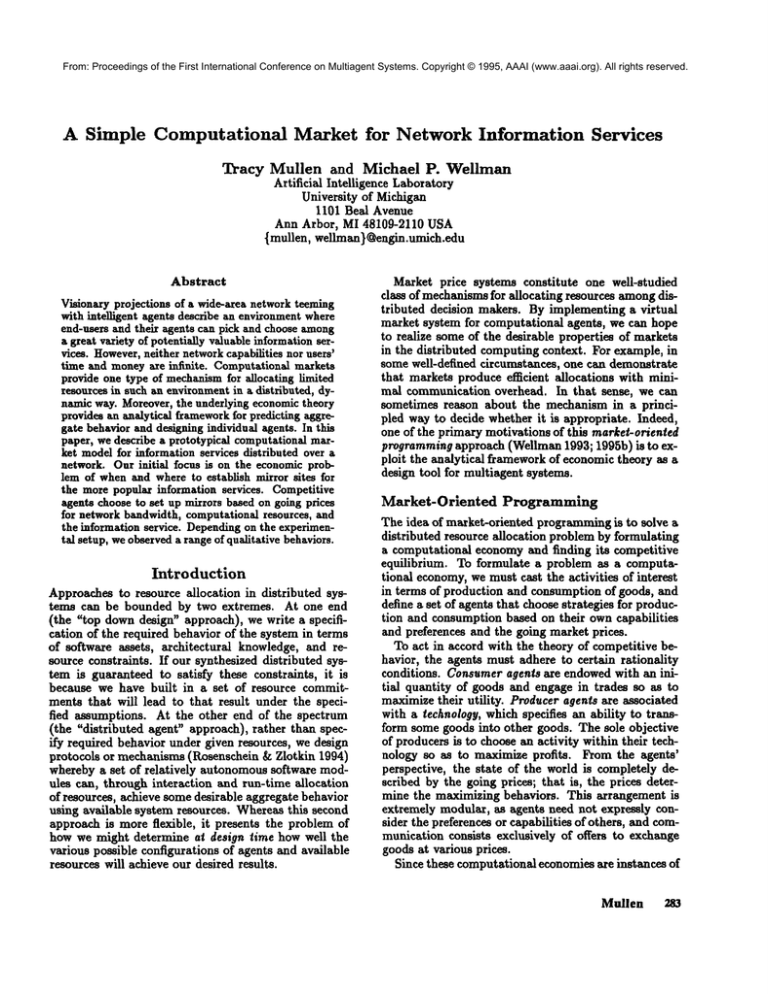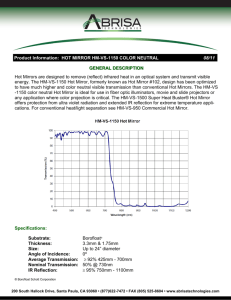
From: Proceedings of the First International Conference on Multiagent Systems. Copyright © 1995, AAAI (www.aaai.org). All rights reserved.
A Simple
Computational
Market for
Network Information
Services
Tracy Mullen and Michael P. Wellman
Artificial Intelligence Laboratory
University of Michigan
1101 Beai Avenue
Ann Arbor, MI 48109-2110 USA
{mullen, wellman } @engin.umich.edu
Abstract
Visionary projections of a wide-axeanetwork teeming
with intelligent agents describe an environmentwhere
end-users and their agents can pick and choose among
a great vaxiety of potentially valuable informationservices. However,neither networkcapabilities nor users’
time and moneyaxe infinite. Computational markets
provide one type of mechanismfor ~llocating limited
resources in such an environmentin a distributed, dynamic way. Moreover,the underlying economictheory
provides an analytical frameworkfor predicting aggregate behavior and designing individual agents. In this
paper, we describe a prototypical computational maxket modelfor information services distributed over a
network. Our initial focus is on the economicproblem of whenand where to establish mirror sites for
the more popular information services. Competitive
agents choose to set up mirrors based on going prices
for network bandwidth, computational resources, and
the information service. Dependingon the experimental setup, weobserveda range of qualitative behaviors.
Introduction
Approaches to resource allocation in distributed systems can be bounded by two extremes. At one end
(the "top down design" approach), we write a specification of the required behavior of the system in terms
of software assets, architectural knowledge, and resource constraints. If our synthesized distributed system is guaranteed to satisfy these constraints, it is
because we have built in a set of resource commitments that will lead to that result under the specified assumptions. At the other end of the spectrum
(the "distributed agent" approach), rather than specify required behavior under given resources, we design
protocols or mechanisms (Rosenschein & Zlotkin 1994)
whereby a set of relatively autonomous software modules can, through interaction and run-time allocation
of resources, achieve somedesirable aggregate behavior
using available system resources. Whereas this second
approach is more flexible, it presents the problem of
how we might determine a~ design ~ime how well the
various possible configurations of agents and available
resources will achieve our desired results.
Market price systems constitute one well-studied
class of mechanismsfor allocating resources amongdistributed decision makers. By implementing a virtual
market system for computational agents, we can hope
to realize some of the desirable properties of markets
in the distributed computing context. For example, in
somewell-defined
circumstances,
onecandemonstrate
thatmarkets
produce
efficient
allocations
withminimal communication
overhead.
In thatsense,we can
sometimes
reasonaboutthe mechanism
in a principledwayto decidewhether
it is appropriate.
Indeed,
oneof theprimary
motivations
of thismarket-oriented
programming
approach
(Wellman
1993;1995b)is to exploittheanalytical
framework
of economic
theoryas a
design
toolformultiagent
systems.
Market-Oriented
Programming
The idea of market-oriented programmingis to solve a
distributed resource allocation problem by formulating
a computational economy and finding its competitive
equilibrium. To formulate a problem as a computational economy,we must cast the activities of interest
in terms of production and consumption of goods, and
define a set of agents that choose strategies for production and consumption based on their own capabilities
and preferences and the going market prices.
To act in accord with the theory of competitive behavior, the agents must adhere to certain rationality
conditions. Consumeragents are endowedwith an initial quantity of goods and engage in trades so as to
maximizetheir utility. Producer agents are associated
with a technology, which specifies an ability to transform some goods into other goods. The sole objective
of producers is to choose an activity within their technology so as to maximize profits. From the agents’
perspective, the state of the world is completely described by the going prices; that is, the prices determine the maximizing behaviors. This arrangement is
extremely
modular,
as agentsneednotexpressly
considerthepreferences
or capabilities
of others,
andcommunication
consists
exclusively
of offersto exchange
goodsat various
prices.
Sincethesecomputational
economies
areinstances
of
Mullen
283
From: Proceedings of the First International Conference on Multiagent Systems. Copyright © 1995, AAAI (www.aaai.org). All rights reserved.
general-equilibrium
systems,
theanalytical
toolsand
results
of genera]
equilibrium
theoryaredirectly
applicable.
In particular,
undercertain
classical
conditions,a simultaneous
equilibrium
of supplyand demandacrossallof thegoodsis guaranteed
to exist,
be reachable
viaa distributed
biddingprocess,
and
be Paretooptimal
(thatis,thereis no solution
that
makes some agentbetteroff withoutmakingsome
otheroneworseoff).Othertheoretical
properties
of
equilibrium
(tobe illustrated
below)canbe used
designers
to configure
thesystemso thatit achieves
somedesiredaggregate
behavior.
Areaswheremarketoriented programming has been applied to date include transportation
planning (Wellman 1993), distributed engineering design (Wellman 1995a), and
allocation of computational resources (Bogan 1994;
Doyle 1994). Although experience with the approach is
still limited, some general understanding of the technique’s characteristics is beginning to emerge (Wellman 1995b).
Some Related
Work
Market or market-like mechanisms have been considered previously in Distributed AI research, most notably in the form of the Contract Net Protocol (Davis
& Smith 1983). Although the contract net per se
did not use real economic mechanisms, some economic concepts can be readily incorporated (Sandholm 1993). Recently, the market approach to resource allocation seems to be gaining in interest in
the distributed computing community, for allocating
computational resources of various kinds (Agorics, Inc.
1994; Clearwater et al. 1995; Ferguson et al. 1995;
Harry & Cheriton 1995; Huberman & Hogg 1995;
Kurose & Simha 1989; Waldspurger et al. 1992). Generally, these applications are centered around a global
model for the resource, from which each agent or module calculates the marginal value of resource for itself.
By using this value for bidding, the market allocates
goods efficiently according to marginal value. An important distinguishing feature of market-oriented programmingis that we are generally concerned with finding an allocation involving multiple interrelated resources. In other words, each agent is potentially
interested in combinations or bundles of goods (resources, services), rather than a single type. For information networks of significant scope, such as digital libraries (Birminghamet al. 1994) or distributed
databases (Stonebraker et al. 1994), it appears inevitable that considering the allocation of multiple resources and services at once will be necessary.
Network Information
Services
Economy
Current users of the internet are witnessing an explosive growth in the number and kind of information
services offered. Weexpect this growth to continue
and accelerate, and eventually for the range of services to start catering toward automated as well as
284
ICMAS-95
human agents. Even in the current environment, economic issues are coming to the fore, as numerous proposals for internet billing protocols, transaction security, and electronic cash are being put forth for consideration. In some proposed schemes for internet pricing (MacKie-Mason& Varian 1994), prices and allocations are determined by dynamic bidding mechanisms.
In such an environment, economically savvy computational agents will be at a premium.
It is widely recognized that the information services network of the future is fertile ground for computational agents. Webelieve moreover that the economic model of agent interaction provides a useful
framework for system design. To explore this possibility, we are currently applying the ideas of marketoriented programming to one large-scale information
services network, the University of Michigan Digital
Library (Birminghamet al. 1994). Our design for this
system is based on a network of specialized information
agents, interacting as suppliers and producers in a virtual information-services economy(Birminghamet al.
1995). Within this system, efficient allocation of basic
computational resources (memory, processing, bandwidth) as well as information goods and more complex
value-added services will be a key to effective behavior
of the overall system.
Blue-Skies
Economy
For our initial exploration of resource allocation on
an information services network, we have developed a
simple computational economyconsisting of one type
of service offered at a variety of sites. The model is
a direct extension of our previously developed transportation economy(Wellman1993), which solved a distributed version of the multicommodity flow problem.
The problem of routing information over a communications network is analogous; here, too, we have to
choose routes simultaneously between several origins
and destinations.
The economic issue we have focused on is the location decision for service provision: when and where
should mirror sites be established? Our initial model
represents a simple network composed of one internet site and two local sites and uses Blue-Skies (Samson, Hay, & Ferguson 1994), (a real-time interactive
weather-images service at the University of Michigan),
as our generic information service. In the model, BlueSkies is produced on the internet and local users access it frequently. To continue accessing Blue-Skies
from the internet means longer delays, but setting up
a mirror site means using up local resources like disk
space and computing, and also imposes an initial overhead cost of transporting the entire product line to the
mirror site. Whichsetup makes more sense clearly depends on these costs, as well as current and anticipated
access patterns by the end users on the local network.
Figure 1 shows how one particular Blue-Skies economy
was configured.
From: Proceedings of the First International Conference on Multiagent Systems. Copyright © 1995, AAAI (www.aaai.org). All rights reserved.
KEY
NETWORK
’ Site
L~N
Sire!
$i~ 2
Figure 1: Blue-Skies Economy
Configuration
In order to design a computational economy, we need
to specify the goods produced and consumed, the
agents participating in the econolny, and the agents’
production and consumption behavior. Selecting the
array of goods available strongly constrains the design
space. The more standardized the goods, the simpler
are the choices for each agent, but the less diverse the
marketplace is. Thus, depending on design requirements, goods may either be decomposed according to
various properties such as location, quality, and timeliness, or else they can be combinedto hide relatively
unimportant distinctions.
In our model, we employed
both of these options. For example, each of our consumers is endowedwith basic network resources which
they can "spend" buying Blue-Skies. Although we
treat network resources as a single good, it actually
denotes an amalgamation of network service characteristics (including throughput and reliability), which together constitute an "effective bandwidth". The units
for this good combine both quantity and quality elements, which can be measured, for example, in terms
of kilobytes of images delivered within a certain time
1
period.
On the other hand, location is an important characteristic here: users want to purchase Blue-Skies, not at
the internet site, but on their local site. Werepresent
this distinction by defining Blue-Skies as a separate
good from Blue-Skies@local-site.
(This is the most
1 Since our entire model operates over the same time
period, it was .not necessaryto explicitly determinewhether
the time period was per hour, per day, or per week.
important way that this model extends the existing
transportation economy.)
Producers are defined by their technology, which describes what resources are required to produce various
amounts of output goods. In our model, we use five
types of producers. Carriers produce transportation
from one node to another, given network resources. We
assume the network is congested, so that the cost per
unit of effective bandwidth provided increases with the
load on the communication link. Like Carriers, manufacturers of cpu access, disk storage, and Blue-Skies
have decreasing returns to scale technologies. The
third kind of producer, transport arbitrageurs, takes
as input transport from node a to node b and transport from node b to node e, and produce as output
transport from a to c. Delivery arbitrageurs are similar, except they bundle information services at a location (e.g., Blue-Skies@internet) with transport from
that location to another (e.g, local-site), to produce
that service at the second location (Blue-Skies@localsite). Finally, our fifth type of producer, the mirror
provider, has the capability of transforming local storage and other resources into provision of the information service at its local site. It can also chooseto access
the service from another site instead of mirroring, in
which case it acts just like the delivery arbitrageur.
If it were possible to provide Blue-Skies using a mixture of sources (i.e., somefrom the net, some locally)
then the two technologies encapsulated by the mirror
provider could just as well be represented by distinct
competing producers.
Consumers are defined by their initial endowment
of resources and their preferences, which dictate the
Mullen
285
From: Proceedings of the First International Conference on Multiagent Systems. Copyright © 1995, AAAI (www.aaai.org). All rights reserved.
E~periment
Choices
Resale
Cache only
internet
internet
mirror
internet
No. i
site 1: mirror, internet
site 2: internet
No. 2
site 1: mirror, internetinternet
internet
site 2: mirror, internet
No. 3
site 1: mirror, internet
site 2: site1, internet
mirror
sitel
mirror/internet
internet/mirror
oscillates
oscillates
Table 1: Experiment Results
relative value to them of alternative combinations of
information services and resource usage. For analytical convenience, we specify preferences using a CES
(constant elasticity of substitution) utility function,
specifying the tradeoff between network resources retained and consumption of the service good, BlueSkies~local-site.
Note that we can view a consumer
agent in this model either as an individual end uscr, or
as an aggregate of all the users at a particular site.
Behavior
of the Model
In running our preliminary experiments, we have considered two different mirror site functions. First, the
mirror serves as a cache for users at its local site. Second, depending on licensing issues, the mirror mayalso
act as a reseller of the informationservice to other sites.
Weran each of our experiments in two configurations.
The first, labeled resale, permitted the mirrors to provide both the cache and resale functions. The second,
cache only, prohibited resale beyond the local site. For
each experiment, Table 1 lists the available choices for
each site, as well as the the final market result for each
configuration.
The economy configuration for Experiment 1 corresponds to that shown in Figure 12. Site 1 must choose
between being a mirror site or getting Blue-Skies from
the internet (site 1: mirror, internet) while site 2 only
had a single option--to get Blue-Skies from the internet (site 2: internet). In the case of the resale mirror,
site 1 chose to get Blue-Skies from the internet. It had
no one to resell the mirrored goods to, so that was not
a profitable choice. For the cache-only setup, site 1
chose to have a mirror site; even though it couldn’t
resell the goods, it was still cheaper (given the cost parameters we used) to cache the product at its site than
to perform all its access over the internet.
The results of all three experiments are what one
would expect, except perhaps for the oscillation occurring in Experiment 3 for the caching mirror. The
2Wehave pictured three separate basic resources in Figure 1 for clarity of understanding. In the actual experiments, they were combinedinto one "Resource"for reasons
discussed below.
286
ICMAS-95
cycling occurs because setting up a mirror site reduces
the overall traffic on the network. This in turn causes
bandwidth prices to drop, which then makes it appear
to the agents that it wouldbe cheaper to get Blue-Skies
via internet. Of course, as soon as they switch to getting the product from the internet, it drives the price
back up, making the mirror appear more profitable. It
is interesting to note, however, that the resale mirror
model does not cycle. Site 1 choosing to be a mirror is
only profitable if site 2 decides to get Blue-Skies from
it, and once the system falls into this optimal choice,
it will stay there.
Oscillation in the system can be attributed to two
main sources: violation of competitive market assumptions and the presence of non-substitutable goods. For
each cause, there are countermeasures available to the
designer of network economies.
The competitive market assumption dictates that
the agents be price takers, ignoring the effect of their
own behavior on the resulting prices. This was clearly
violated in our third experiment above, where the
choice of one mirror producer dramatically influenced
traffic and thereby moved prices. Weexpect that expanding the scale of the network economy, thus decreasing the influence of any one agent, wouldmitigate
the effect on prices and tend to reduce the likelihood
of the kind of synchronous flip-flop behavior seen in
Experiment 3.
Non-substitutability
of goods caused a problem in
our original configuration, where we had separate
goods for each kind of production resource: transportation, internet, and machine resources. Convergence
was hindered by the fact that prices go to zero whenever there is an excess supply of some good. In our
early tests, when site 1 chose to be mirror site, the
economy was left with a large amount of transportation goods that could not be used elsewhere. Merging
the three goods resolved that problem by making the
different resources substitutable. However, the longterm solution here is also to scale up the economy.As
long as there is some potential use for the excess transportation resources in the economy(even a very lowvalued one), the problem of zero prices (and hence zero
income for the consumers who own the resources) does
From: Proceedings of the First International Conference on Multiagent Systems. Copyright © 1995, AAAI (www.aaai.org). All rights reserved.
Blue-Skies:
Demand Function:
Historical Supply:
Minimum Input:
Manufacturer
z = .01y 2 + .Sy
y = 400 units Blue-SkiesQinternet
1,800 units Network resources
Delivery(internet,sitel):
Production Function:
Demand Function:
Historical Supply:
Minimum Input:
Arbitrageur
y = min(zl, :r,2)
x=y
y = 200 units BlueSkies~sitel
200 units Blue-Skies@internet
200 units Link(internet,sitel)
AND
Table 2: MinimumInput Requirements
not arise.
In summary, we have defined a very simple computational market model for setting up mirror sites on an
information services network. The model behaves predictably according to market principles, and exhibits
a range of qualitatively distinct behaviors according to
the market structure.
Designing
a Blue-Skies
Consumer
A consumer is defined by its initial endowment(which
dictates its budget), and its preferences for different
combinations of goods. If this information has not
been specified externally, then it is up to the designers
of the multiagent system to choose appropriate parameters. Andas we have seen above, different configurations and parameters can lead to qualitatively different
overall behaviors.
One of the benefits of the economic framework is
that we can use the properties of competitive equilibrium derived from the underlying theory to design
agents that will achieve the desired results. Although
the following analysis is specific to the Blue-Skies economy, it demonstrates more generally the methodological utility of adopting a frameworkwith firm theoretical underpinnings.
Based on our problem description, we made two assumptions. First, that the amount of Blue-Skies demanded historically (i.e., when local sites were supplied with Blue-Skies from the internet) was known,
and that historic demand is an appropriate benchmark
for demand in the expanded model with mirroring.
Second, we assume that the CES utility function is
a reasonable model of preferences. Given these two
assumptions, our task is to set the parameters of the
computational economy so that consumers can support
their historic demands.
Finding
the Initial
Endowments
In any economy, producing a given amount of output requires some minimumamount of input be available. Since all of the basic resources are initially owned
by the consumers, we have to make sure that the total endowmentallocated to consumers is at least the
minimumamount required to produce the desired aggregate output. Historical demand data tells us how
much output was produced, so by working backwards
through the production technologies we can derive the
minimumamount of basic resource necessary. In Table 2, minimuminput amounts are calculated for two
particular producers. Similar calculations can be carried out for all the producers in the network.
Initial endowment amounts can then be determined
in one of two ways, depending on the symmetry of
the economic configuration. For symmetric economies,
(where the network is symmetric and consumers have
identical preferences), each consumer is assigned an
equal share of the required input goods. Otherwise,
one reasonable estimate of the required endowmentis
in proportion to the historical demands. Since our experimental economyis symmetric, we divide the total
amount of network resources required (170,800 units)
equally between our two consumers.
Utility
Function
Parameters
The CESutility function (for n goods) has the following form:
ft
=
(1)
i=1
The coefficients c~ weight the consumer’s preference
for each good, and the p parameter controls the substitutability
between goods. For concreteness, we arbitrarily set p = 1/9. and seek a set of as such that
each consumer spends their network resources to buy
Blue-Skies. Let p = (Pl,... ,Pn) be the vector of prices
Mullen
287
From: Proceedings of the First International Conference on Multiagent Systems. Copyright © 1995, AAAI (www.aaai.org). All rights reserved.
for the n goods. The demand function zi for good i,
derived from maximizing the utility function subject
to the budget constraint (total expenditures equal income) is:
zi(p,
income) cqP~l/2inc°me
Our requirement is that the consumer’s demands at
equilibrium match the historical
demand. Unfortunately, ensuring this is not as straightforward as it
might seem; to evaluate the demand function we need
to know the equilibrium prices, and the equilibrium
prices depend on the demands. However, using the
competitiveness assumption we can determine analytically the relative prices of the economyat equilibrium.
First, we use the fact that in equilibrium, price
equals marginal cost (MC). If the cost c(y) of producing y units of output is measuredin units of input, then
MC(y) -- Pout/Pin, where Pout is the price of output,
Pin the price of input, and MC(y) the derivative of
c(y).
For example, the Blue-Skies producer has an input of network resources and an output of BlueSkies@internet. Let the prices of these goods be Pnr
and Pba, respectively.
Since the cost function for
this producer is c(y) -- .01# 2 + .Sy, it follows that
MC(y) .0 2y + .5 . Us ing th e hi storical de
mand
of y -- 400, at equilibrium it must be the case that
MC(400)-- .02(400) + .5 Pb,/P,~r. From this we can
derive a constraint on the relative equilibrium prices,
Pb, = 8.5pnr.
By a similar analysis of the other producers’ technologies, we can derive constraints on other combinations of relative prices, and then propagate these
to express constraints between any connected pair of
prices. For example, from the delivery arbitrageur we
can determine that the price of Blue-Skies@sitel (Pb, t)
equals the sum of prices of Blue-Skies@internet (PbJ)
and transportation to sitel, which (via someother constraints) comes out to 824.5pn~. Combiningthis with
the constraint above yields Pb,1 = 833pn~.
Wecan also use the fact that for each consumer (in
equilibrium), the ratio of its marginal utilities for pairs
of goods equals the ratio of the prices for those goods.
From this we can derive constraints on the ~i parameters of the consumer’s CESutility function. Wecalculate marginal utility (MU)by taking the derivative
of the CESutility function (1),
MUi= __p_p-t
Pcxi ~i
"
Since p < 1, this means that marginal utility is undefined at zi = 0. Therefore, even though the consumers
really want network resources only for the purpose of
trading them for Blue-Skies, we require that the consumers have someother direct use for the resource, not
explicitly modeled by the economy. To ensure this, we
arbitrarily set the consumptionvalues for the resource
288
iCMAS-9$
goods to some small amount, for example, Znr - 16.
Solving for consumer@sitel (using p = 1/2), we have:
MUnr
-z12
112
= 1/2o~112
m. (16) = 1/8an,.
MUb.1 -~
1/2
1/2~b.1(200
I/:~
--1/2: V/2/40OCb~l
2
)
From the analysis of producers above, we know
that Pbal -" 833pnr. Using the equilibrium condition
MUi/MUj= Pi/Pj, we can find the relative values for
the CES ~ parameters:
MUb,
I/MUnr
112 112
(V~/5)(c%,i/ct.r
-" Pb, I/Pnr
-- (833pnr)/Pnr
1/2
hal
~b,l
=
(4165/vr~)~1/2
-(8.67 x lOS)~,~
If we set ~nr = 1, we will thus have one particular
realization of a Blue-Skies consumer. And, since this is
a symmetric economy, the consumer@site2 is the same,
Oebj1 -- .3
~bs2
Note that in the foregoing analysis, we madeseveral
arbitrary choices (p -- 1/2, C~nr : I, Znr = 16). This
is simply because the problem is underconstrained. To
achieve a given behavior, there are in general many
parameter settings that will do the job. If we had
further behavioral constraints, these arbitrary settings
are available as extra degrees of freedom.
Finally, we note that indeed, when run under WAL~tAS (our market-oriented programming environment,
see (Wellman 1993)), this economy in fact produces
the expected results. That is, the theoretical analysis
is in fact validated by the behavior actually resulting
from the distributed bidding behavior of the consumer
agents we constructed.
Conclusion
Preliminary results showthat under certain conditions
the optimal mirror site configuration is chosen. However, because the current model is so small, problems
with the competitiveness assumption and the limited
range of resource-usage opportunities can cause the
economy to oscillate. The solution to these problems
is to scale up the economyby expanding the number of
sites, adding more services, and distinguishing services
based on different quality features, (e.g., having mirror sites that update less frequently but are cheaper,
s For non-symmetriceconomies,we mayalso need to calculate the profits of the producers,in order to use relationships depending on the income of consumers. For example, to find the Bhe-Skiesproducer’sprofit (revenue minus
cost):
PnrY -- C(y)pb,
~-
400pb. -- 1800pnr
=
=
400(8.5p,,)- 1800p.,
1600pnp.
From: Proceedings of the First International Conference on Multiagent Systems. Copyright © 1995, AAAI (www.aaai.org). All rights reserved.
or more expensive sites carry a higher-quality version
of Blue-Skies).
Other extensions include providing for explicit trading of licensing and distribution rights, and exchange
of resources across multiple time periods. Weexpect
thatpractical
deployment
of thismodelwillalsorequirecompromises
of the pureeconomicframework.
Forexample,
it wouldnotbe reasonable
in general
for
thenetwork
of agentsto reacha competitive
equilibriumforeachtransaction,
sodifferent
kindsof bidding
protocols
and periodicprice-adjustment
mechanisms
willhaveto be explored.
Broaderaimsincludedeveloping
generalmethodologies,
andwhenever
possible,
analytic
techniques,
for determining and directing the behavior of the system by specifying the initial economic configuration
and the appropriate incentive mechanisms (possibly
through taxes or subsidies). Although decentralized
consumer and producer agents can act on these incentives in whatever manner they see fit individually,
confidence in the aggregate behavior of the system can
be maintained.
References
Agorics, Inc. 1994. Real-time video delivery with
market-based resource allocation. Technical Report
ADd004P,Agorics, Inc.
Birmingham,W. P.; Drabenstott, K. M.; Frost, C. O.;
Warner, A. J.; and Willis, K. 1994. The University
of Michigan Digital Library: This is not your father’s
library. In Proceedingsof Digital Libraries ’g4, 53-60.
Birmingham, W. P.; Duffee, E. H.; Mullen, T.; and
Wellman, M. P. 1995. The distributed agent architecture of the University of Michigan Digital Library
(extended abstract).
In AAAI Spring Symposium on
Information Gathering in Heterogeneous, Distributed
Environments.
Bogan, N. R. 1994. Economic allocation of computation time with computation markets. Master’s thesis,
Massachusetts Institute of Technology, Department of
Electrical Engineering and Computer Science.
Clearwater, S. H.; Costanza, R.; Dixon, M.; and
Sc~roeder, B. 1995. Saving energy using marketbased control. In Clearwater (1995).
Clearwater, S. H., ed. 1995. Market-Based Control: A
Paradigm.for Distributed Resource Allocation. World
Scientific.
Davis, R., and Smith, R. G. 1983. Negotiation as a
metaphor for distributed problem solving. Artificial
Intelligence 20:63-109.
Doyle, J. 1994. A reasoning economy for planning
and replanning. In Technical Papers of the ARPA
Planning Initiative Workshop.
Ferguson, D. F.; Nikolaou, C.; Sairamesh, J.; and
Yemini,Y. 1995.Economicmodelsfor allocating
resources
in computer
systems.
In Clearwater
(1995).
Harty, K., and Cheriton, D. 1995. A market approach
to operating system memoryallocation. In Clearwater (1995).
Huberman, B. A., and Hogg, T. 1995. Distributed
computation as an economic system. Journal of Economic Perspectives 9(1):141-152.
Kurose, J. F., and Simha, It. 1989. A microeconomic
approach to optimal resource allocation in distributed
computer systems. IEEE Transactions on Computers
38(5):705-717.
MacKie-Mason,
J. K., andVarian,H. R. 1994.Pricingtheinternet.
In Kahin,
B.,andKellex,
].,eds.,
Public Access to the Internet. Prentice-Hall.
Rosenschein, J. S., and Zlotkin, G. 1994. Rules of Encounter: Designing Conventions for Automated Negotiation among Computers. MIT Press.
Samson, P. J.; Hay, K.; and Ferguson, J. 1994. Blueskies: Curriculum development for k-12 education. In
American Meteroiogical Society Conference on Interactive Information and Processing Systems.
Sandholm, T. 1993. An implementation of the contract net protocol based on marginal cost calculations.
In Proceedings of the National Conference on Artificial Intelligence, 256-282. Washington, DC: AAAI.
Stonebraker, M.; Devine, R.; Kornacker, M.; Litwin,
W.; Pfeffer, A.; Sah, A.; and Staelin, C. 1994. An
economic paradigm for query processing and data migration in Mariposa. In Third International Conf. on
Parallel and Distributed Information Systems.
Waldspurger, C. A.; Hogg, T.; Huberman, B. A.;
Kepheat, J. O.; and Stornetta, S. 1992. Spawn: A distributed computational economy. IEEE Transactions
on Software Engineering 18:103-117.
Wellman, M. P. 1993. A market-oriented
programming environment and its application to distributed
multicommodity flow problems. Journal of Artificial
Intelligence Research 1:1-22.
Wellman, M. P. 1995a. A computational
market model for distributed configuration design. AI
EDAM.
WeUman, M. P. 1995b. Market-oriented
programming: Someearly lessons. In Clearwater (1995).
Mullen
289






